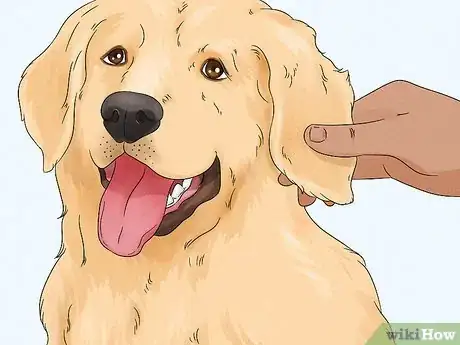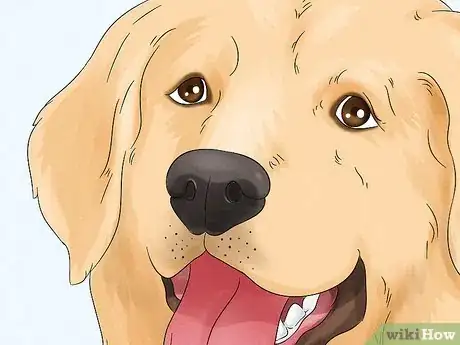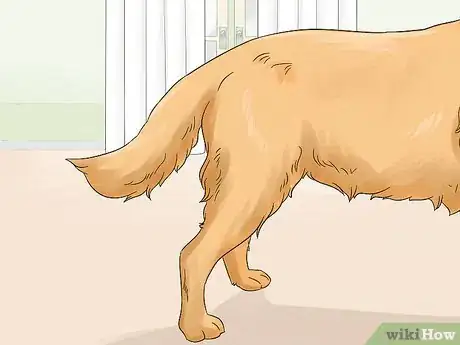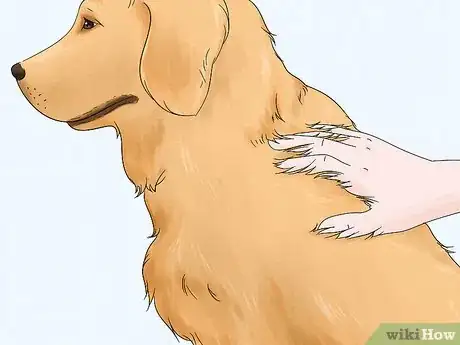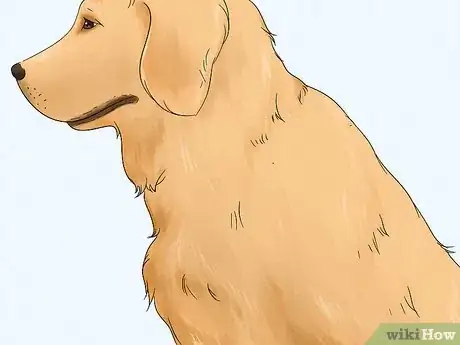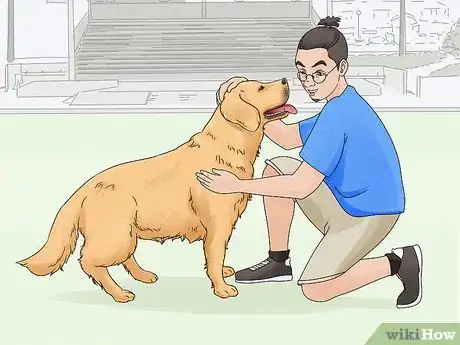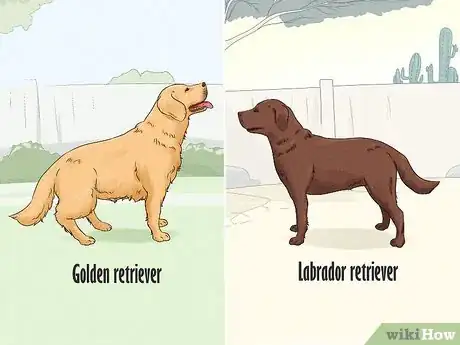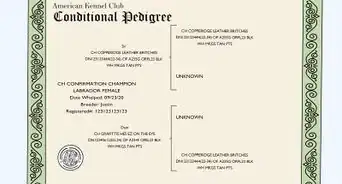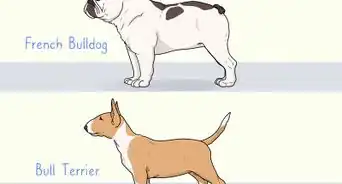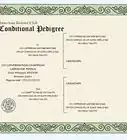wikiHow is a “wiki,” similar to Wikipedia, which means that many of our articles are co-written by multiple authors. To create this article, volunteer authors worked to edit and improve it over time.
There are 15 references cited in this article, which can be found at the bottom of the page.
This article has been viewed 86,703 times.
Learn more...
One of the most popular dog breeds, Golden Retrievers are known for their positive temperament and athleticism. They are devoted members of the sporting group[1] and are commonly used for jobs such as guide dogs. This wikiHow will help you recognize key traits to determine whether or not a dog is a Golden Retriever.
Steps
Checking the Body Structure
-
1View the size of the dog. Golden Retrievers are medium-sized dogs. Males are 23–24 inches (58–61 cm) tall, weighing 65–75 pounds (29–34 kg), while females are 21.5–22.5 inches (55–57 cm) tall and weigh 55–65 pounds (25–29 kg).[2]
-
2Check the ears. Golden Retrievers have rather short ears. The front edges are attached behind and just above the eyes.[3] The tips fall close to the dog's cheeks and, if pulled over, should cover the eyes.[4]Advertisement
-
3Look at the eyes. A Golden Retriever's eyes are medium-large, and they can be either medium or dark brown with dark eye rims.[5] They give the dog an intelligent, friendly expression.
-
4See the dog's tail. The tail of a Golden Retriever is thick and muscular at the base. It is carried level or moderately curved upward, though never curled or between the legs.[6]
-
5
Examining the Coat
-
1
-
2See if the coat is a golden shade. Golden Retrievers are named for their golden coats. Their coats are a "rich, lustrous golden of various shades",[11] which can range from a light cream color to a deep reddish gold.
-
3Identify feathering. Like some other breeds, Golden Retrievers are seen with feathering. Feathering is defined as a "longer fringe of hair on ears, legs, tail, or body".[12] This feathering, which appears on a Golden Retriever's legs, tail, neck, and underbody, may be lighter than the rest of the coat.[13]
Recognizing Temperament
-
1See how active the dog is. Golden Retrievers have high energy levels and are active and athletic. These retrievers need regular exercise to stay satisfied.[14]
-
2Notice loyalty. Golden Retrievers can develop deep bonds with their owners.[15] They demonstrate loyalty to those they spend the most time with and may feel anxious when they're alone.
Did you know? Golden Retrievers are a common breed employed to be therapy dogs. Their kind-hearted, loving, empathetic personalities are known for being able to calm people of all ages.[16]
-
3Pay attention to how entertained the dog is. If they're not occupied, Golden Retrievers can easily become bored. It is important that they have things to do to prevent this.[17]
-
4Look for a trustworthy personality. Golden Retrievers are reliable dogs. With proper socialization, this trait allows them to make great family pets, and they can be trusted around children with supervision.[18]
-
5Check for adaptability. Some breeds don't do well with other pets, but Golden Retrievers are typically adaptable. Many Golden Retrievers can live peacefully with other animals, such as cats.[19]
Distinguishing Between Retrievers
Golden Retrievers are just one of six retrieving breeds.[20] It can be difficult to tell Goldens apart from these other retrievers, but if you familiarize yourself with the differences between them, it can be easier to tell whether or not a dog is a Golden Retriever.
-
1Tell how Golden Retrievers and Chesapeake Bay Retrievers differ. The Chesapeake Bay Retriever, also referred to as a Chessie, is a retrieving breed from the Mid-Atlantic.[21] One noticeable difference between the breeds is that Chessies have wavy fur that is dense, thick, and short.[22] A Chessie's coat is brown, resembling nature to blend in, though one may have minimal white markings on the feet or stomach.[23] They are brave, love water, and are willing to work.
-
2Recognize the differences between Golden Retrievers and Nova Scotia Duck Tolling Retrievers. The Nova Scotia Duck Tolling Retriever, also called a Toller, is a retriever of unknown breeding origin, but it was bred to hunt ducks.[24] Tollers are smaller than Goldens, being the smallest of the retriever breeds.[25] They have mostly straight, red coats that range from golden red to a deep coppery red, with white markings on the tail tip, feet, chest, or blaze.[26] Tollers are quick, alert, and determined, and they may even have a slightly worried or sad expression when they aren't working.[27]
-
3Understand how Golden Retrievers and Flat-Coated Retrievers differ. Flat-Coated Retrievers are also called Flat-Coats and were bred in the mid-1800s.[28] They are fairly similar in size to Goldens but have long, flat muzzles.[29] Flat-Coats have straight, flat-lying coats that can be either solid black or solid liver.[30] They are sensible, alert, and cheerful.
Did you know? When Golden Retrievers were first shown at England's Crystal Palace show in 1908, they were listed as "Flat-Coats (Golden)".[31]
-
4Distinguish between Golden Retrievers and Curly-Coated Retrievers. Curly-Coated Retrievers, or Curlies, are among the oldest of the retrievers.[32] Curlies are larger than Goldens, weighing as much as 60–95 pounds (27–43 kg).[33] They have unique wedge-shaped heads, and, as their name suggests, coats consisting of short, tight curls, which come in solid black and solid liver.[34] Curlies are gentle, affectionate, and more independent than Goldens.
-
5Spot differences between Golden Retrievers and Labrador Retrievers. The Labrador Retriever, or Lab, is another popular retrieving breed. Labs are roughly the same size as Goldens, though they have a larger scale height- and weight-wise.[35] Labs can be seen in colors other than gold - their coats can be solid yellow, brown, or black.[36] Golden Retrievers are typically calmer than Labs.
Community Q&A
-
QuestionWhy is my Golden Retriever brown?
 LinnieTop AnswererWhat you consider brown is likely a deep golden brown color. Golden Retrievers may be any shade of gold, including darker gold that resembles brown and even reddish brown gold. If you believe your dog is a non-golden shade of brown, however, such as chocolate, it may not be a purebred Golden Retriever.
LinnieTop AnswererWhat you consider brown is likely a deep golden brown color. Golden Retrievers may be any shade of gold, including darker gold that resembles brown and even reddish brown gold. If you believe your dog is a non-golden shade of brown, however, such as chocolate, it may not be a purebred Golden Retriever. -
QuestionDo some Golden Retrievers have feathering on their feet?
 LinnieTop AnswererYes, it is possible for the feathering on a Golden Retriever's legs to reach the feet.
LinnieTop AnswererYes, it is possible for the feathering on a Golden Retriever's legs to reach the feet. -
QuestionI got my golden retriever online with no paperwork. She is smaller than my other goldens, but I am unable to afford a DNA test to confirm her breed. Is she just a small golden retriever, or is she a mixed breed?
 LinnieTop AnswererMost golden retrievers are roughly medium in size, being between 20-25 inches or so in height. If your golden retriever is somewhere within this range and resembles a golden retriever otherwise, she is probably a purebred. However, if she's smaller than this but still resembles a golden retriever, it's possible that she may be a "mini golden retriever", which is a newer mixed breed comprised of golden retriever and another breed, typically cocker spaniel or poodle, if not both, to be a smaller version of a golden retriever.
LinnieTop AnswererMost golden retrievers are roughly medium in size, being between 20-25 inches or so in height. If your golden retriever is somewhere within this range and resembles a golden retriever otherwise, she is probably a purebred. However, if she's smaller than this but still resembles a golden retriever, it's possible that she may be a "mini golden retriever", which is a newer mixed breed comprised of golden retriever and another breed, typically cocker spaniel or poodle, if not both, to be a smaller version of a golden retriever.
References
- ↑ https://www.akc.org/dog-breeds/golden-retriever/
- ↑ https://www.akc.org/dog-breeds/golden-retriever/
- ↑ http://images.akc.org/pdf/breeds/standards/GoldenRetriever.pdf
- ↑ http://images.akc.org/pdf/breeds/standards/GoldenRetriever.pdf
- ↑ http://images.akc.org/pdf/breeds/standards/GoldenRetriever.pdf
- ↑ http://images.akc.org/pdf/breeds/standards/GoldenRetriever.pdf
- ↑ http://images.akc.org/pdf/breeds/standards/GoldenRetriever.pdf
- ↑ http://images.akc.org/pdf/breeds/standards/GoldenRetriever.pdf
- ↑ http://images.akc.org/pdf/breeds/standards/GoldenRetriever.pdf
- ↑ http://images.akc.org/pdf/breeds/standards/GoldenRetriever.pdf
- ↑ http://images.akc.org/pdf/breeds/standards/GoldenRetriever.pdf
- ↑ https://www.akc.org/about/glossary/
- ↑ http://images.akc.org/pdf/breeds/standards/GoldenRetriever.pdf
- ↑ https://www.dogtemperament.com/golden-retriever-temperament/
- ↑ https://www.dogtemperament.com/golden-retriever-temperament/
- ↑ https://www.akc.org/expert-advice/dog-breeds/10-facts-about-golden-retrievers/
- ↑ https://www.dogtemperament.com/golden-retriever-temperament/
- ↑ https://www.dogtemperament.com/golden-retriever-temperament/
- ↑ https://www.dogtemperament.com/golden-retriever-temperament/
- ↑ https://www.akc.org/expert-advice/lifestyle/the-retrievers-ever-talented-and-willing-to-please/
- ↑ https://www.akc.org/dog-breeds/chesapeake-bay-retriever/
- ↑ http://images.akc.org/pdf/breeds/standards/ChesapeakeBayRetriever.pdf
- ↑ http://images.akc.org/pdf/breeds/standards/ChesapeakeBayRetriever.pdf
- ↑ https://www.akc.org/dog-breeds/nova-scotia-duck-tolling-retriever/
- ↑ https://www.akc.org/dog-breeds/nova-scotia-duck-tolling-retriever/
- ↑ http://images.akc.org/pdf/breeds/standards/NovaScotiaDuckTollingRetriever.pdf
- ↑ http://images.akc.org/pdf/breeds/standards/NovaScotiaDuckTollingRetriever.pdf
- ↑ https://www.akc.org/dog-breeds/flat-coated-retriever/
- ↑ http://images.akc.org/pdf/breeds/standards/FlatCoatedRetriever.pdf
- ↑ http://images.akc.org/pdf/breeds/standards/FlatCoatedRetriever.pdf
- ↑ https://www.akc.org/dog-breeds/golden-retriever/
- ↑ https://www.akc.org/dog-breeds/curly-coated-retriever/
- ↑ https://www.akc.org/dog-breeds/curly-coated-retriever/
- ↑ https://www.akc.org/dog-breeds/curly-coated-retriever/
- ↑ https://www.akc.org/dog-breeds/labrador-retriever/
- ↑ https://images.akc.org/pdf/breeds/standards/LabradorRetriever.pdf

